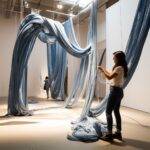Larger-than-life sea creature sculptures have taken center stage at Tucson Botanical Gardens, located at 2150 N. Alvernon Way, running from January 26 to June 30. However, these captivating sculptures are not merely artistic creations; they carry a profound message about the impact of pollution on marine life.
Innovative Construction from Marine Debris
According to a news release from Tucson Botanical Gardens, each sculpture showcased in the exhibition, titled “Washed Ashore: Art to Save the Sea,” has been meticulously crafted from marine debris. This unique approach not only transforms discarded materials into compelling art but also serves as a poignant reminder of the consequences of pollution in our oceans.
Inspiring Change: The Purpose Behind the Exhibit
The primary goal of the Washed Ashore exhibit is to raise awareness about the detrimental effects of pollution on sea life. By using marine debris as the medium for these sculptures, the creators aim to inspire individuals to reduce their consumption of single-use plastics. The exhibit seeks to prompt viewers to reflect on their environmental impact and reconsider their daily choices in favor of a more sustainable lifestyle.
Collaborative Efforts with Washed Ashore
The Washed Ashore exhibit is the result of a collaboration between Tucson Botanical Gardens and Washed Ashore, a nonprofit organization based in Oregon. Over the past decade, Washed Ashore has managed to transform more than 35 tons of marine debris into 85 works of art. This collaboration not only highlights the creative potential of upcycling but also emphasizes the urgency of addressing the global issue of plastic pollution.
National Recognition: Display at the Smithsonian
The impactful works of Washed Ashore have not gone unnoticed, as they have previously been featured at prestigious venues such as the Smithsonian National Museum of Natural History in Washington D.C. The exhibit’s inclusion at such renowned institutions underscores the significance of using art as a medium to communicate pressing environmental concerns.
Statistics Highlighting the Scale of Marine Debris
To comprehend the scale of the issue at hand, it is essential to consider some alarming statistics related to marine debris. According to the Ocean Conservancy, an estimated 8 million metric tons of plastic enter the ocean annually, endangering marine life and ecosystems. The Washed Ashore exhibit serves as a visual representation of this staggering environmental challenge, encouraging viewers to take proactive steps in addressing the crisis.
A Call to Action: Reducing Single-Use Plastics
As the Washed Ashore exhibit unfolds at Tucson Botanical Gardens, it extends a compelling call to action. Beyond appreciating the artistic brilliance of the sculptures, visitors are prompted to rethink their consumption habits and contribute to the reduction of single-use plastics. The exhibit acts as a catalyst for change, inviting individuals to become advocates for a cleaner, healthier ocean.
Embracing Sustainability through Art
In conclusion, the Washed Ashore exhibit at Tucson Botanical Gardens serves as a powerful convergence of art and environmental advocacy. By transforming marine debris into awe-inspiring sculptures, the exhibit not only captures attention but also sparks crucial conversations about the need for sustainable practices. In a world grappling with the consequences of plastic pollution, this artistic endeavor stands as a testament to the potential for positive change through collective awareness and action.








Leave a Reply